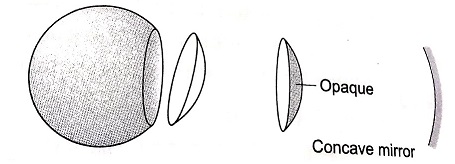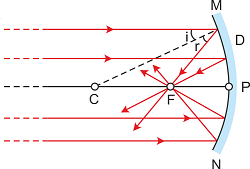Converging Mirror or Concave Mirror










Converging Mirror or Concave Mirror
Converging Mirror or Concave Mirror
Concave Mirror can be considered as a part of a sphere. Consider a hollow glass sphere and cut a piece of the sphere as shown in the figure. The cut off piece has two surfaces, one which is bulging out or convex surface and other is a hollow surface that is on the same side as the centre of the original sphere is called as concave surface.

If we polish the bulging surface or convex surface with silver and look at it from the hollow side or concave surface, we have a concave mirror. These mirrors, which are referred to as convergent mirrors, concentrate the light rays, coming parallel to the principal axis causing them to converge on to a point known as the focal point. Concave mirrors form real images that can be projected on to a screen if the object is farther away than the focal point. The image obtained is large if formed near the focal point or small if formed far away from the focal point. In both cases, the image is reversed. If we place the object closer than the focal point, the image is formed upright and large but virtual (i.e., it cannot be projected).
Reflection Through Concave Mirror :
When a narrow beam of light traveling parallel to the principal axis is incident on the reflecting surface of a concave mirror,as shown in the figure, each ray is reflected according to the laws of reflection and converge to a point F on the principal axis known as the focus. As the rays are converging after reflection the concave mirror is also called converging mirror.

USES OF CONCAVE MIRRORS:
Which of the following are correct : (a) Concave mirrors are commonly used in torches, search-lights and vehicles headlights to get powerful parallel beams of light. (b) Concave mirrors are used as shaving mirrors to see larger image of the face. (c) Convex mirrors are used as shaving mirrors to see larger image of the face.
| |||
| Right Option : A | |||
| View Explanation | |||
A spherical mirror whose inner hollow surface is the reflecting surface is a _______________ | |||
| Right Option : B | |||
| View Explanation | |||
Which of the following are correct : (a) Concave mirror is also called converging mirror. (b) Convex mirror is also called converging mirror. (c) Dentists use concave mirrors to see large images of the teeth. (d) Dentists use convex mirrors to see large images of the teeth. | |||
| Right Option : C | |||
| View Explanation | |||
Students / Parents Reviews [10]
My experience with Abhyas academy is very good. I did not think that my every subject coming here will be so strong. The main thing is that the online tests had made me learn here more things.

Hiya Gupta
8thBeing a parent, I saw my daughter improvement in her studies by seeing a good result in all day to day compititive exam TMO, NSO, IEO etc and as well as studies. I have got a fruitful result from my daughter.

Prisha Gupta
8thIt was good as the experience because as we had come here we had been improved in a such envirnment created here.Extra is taught which is beneficial for future.

Eshan Arora
8thMy experience with Abhyas is very good. I have learnt many things here like vedic maths and reasoning also. Teachers here first take our doubts and then there are assignments to verify our weak points.

Shivam Rana
7thIt was a good experience with Abhyas Academy. I even faced problems in starting but slowly and steadily overcomed. Especially reasoning classes helped me a lot.

Cheshta
10thOne of the best institutes to develope a child interest in studies.Provides SST and English knowledge also unlike other institutes. Teachers are co operative and friendly online tests andPPT develope practical knowledge also.

Aman Kumar Shrivastava
10thAbhyas Methodology is very good. It is based on according to student and each child manages accordingly to its properly. Methodology has improved the abilities of students to shine them in future.

Manish Kumar
10thIt has a great methodology. Students here can get analysis to their test quickly.We can learn easily through PPTs and the testing methods are good. We know that where we have to practice

Barkha Arora
10thMy experience was very good with Abhyas academy. I am studying here from 6th class and I am satisfied by its results in my life. I improved a lot here ahead of school syllabus.

Ayan Ghosh
8thAbhyas is a complete education Institute. Here extreme care is taken by teacher with the help of regular exam. Extra classes also conducted by the institute, if the student is weak.
